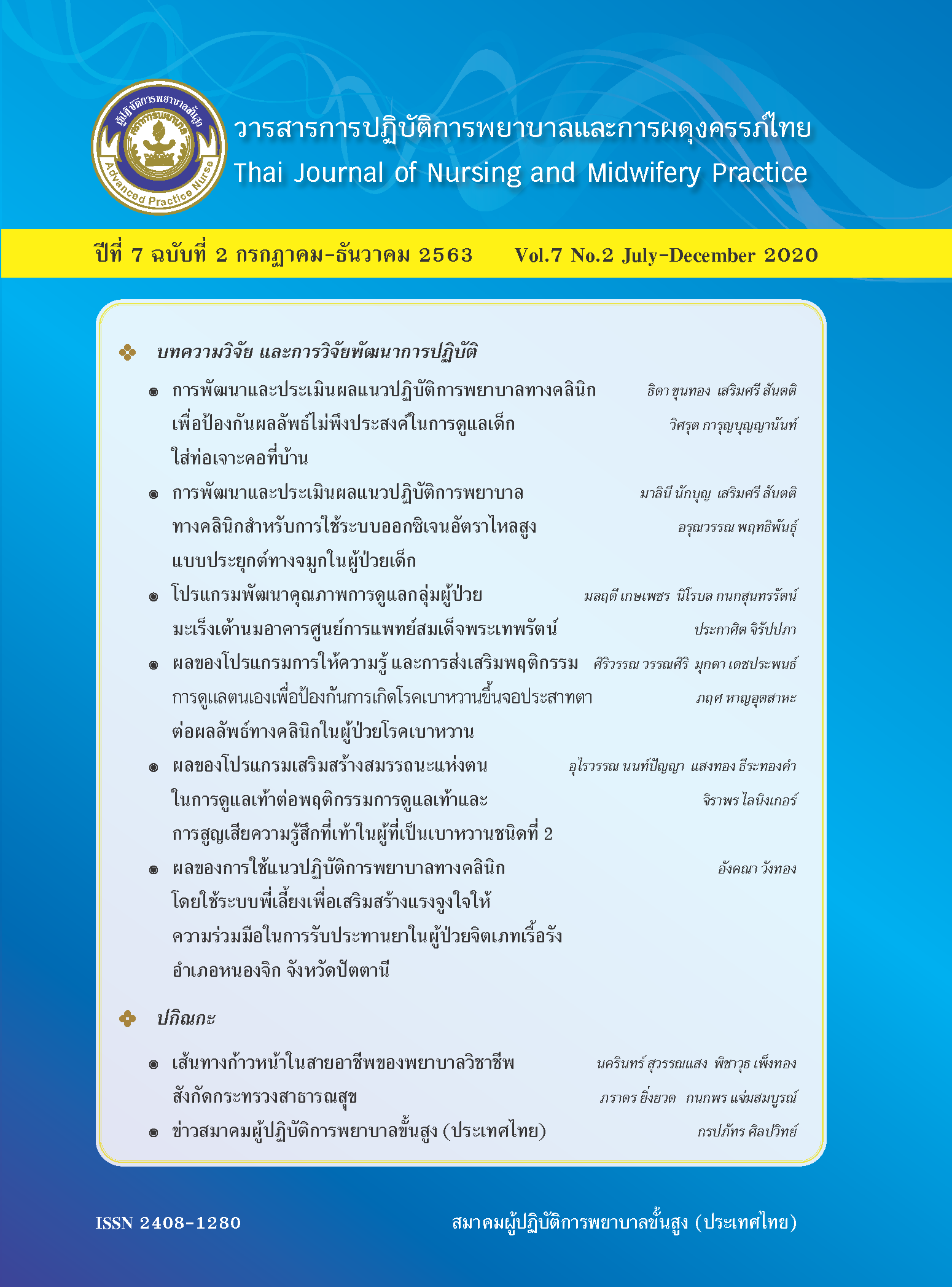The development and evaluation of clinical nursing practice guideline for modified high flow nasal cannula system in pediatric patients
Main Article Content
Abstract
Abstract: Development and implementation of clinical nursing practice guideline (CNPG) provides good outcomes of care. This research aimed to develop the CNPG using the evidence-based practice model of Soukup. The samples were 25 nurses and 25 pediatric patients with modified high flow nasal cannula system (MHFNCS) who ages ranged from 1 month to 5 years in the pediatric wards of a university hospital. Data
collection tools were: (1) clinical data record form for MHFNCS; (2) nurse’s skill assessment form; (3) feasibility of guideline implementation questionnaire; and (4) nurses’ satisfaction with the CNPG implementation questionnaire. Data were analyzed by descriptive statistics. Results showed that: (1) the CNPG comprised of 3 components: 1) preparation and composition of MHFNCS devices; 2) initial setting up and taking care of MHFNCS; and 3) nursing care of pediatric patients with MHFNCS. (2)The results of the CNPG implementation revealed the feasibility of CNPG implementation at the high level (Mean = 4.34, SD = 0.39). Nurses’ satisfaction on the CNPG implementation was at the high level. (Mean = 4.31, SD = 0.45). It is recommended that the developed CNPG is appropriately use in clinical settings. It should be further
continuously used, monitored, evaluated and refined.
Downloads
Article Details
References
เอกสารอ้างอิง
Lee JH, Rehder KJ, Williford L, Cheifetz IM,Turner DA. Use of high flow nasal cannula in critically ill infants children and adults:a critical review of the literature. Intens care Med 2013;39(2):247-57.
Hutchings FA, Hilliard TN, Davi PJ. Heated humidified high flow nasal cannula therapy in children. Arch Dis Child 2015;100(6):571-5.
Spentzas T, Minarik M, Patters AB,Vinson B, Stidham G. Children with respiratory distress treated with high flow nasal cannula. J Intens care Med 2009;24(5):323-8.
Mikalsen IB, Davis P, Øymar K. High flow nasal cannula in children: a literature review. Scandinavian J Trauma Resusc Emerg Med 2016;24(93):1-12.
Wing R, James C, Maranda LS, Armsby CC. Use of high-flow nasal cannula support in the emergency department reduces the need for intubation in pediatric acute respiratory insufficiency. Pediatr Emerg Care 2012;28(11):1117-23.
Franklin D, Babl FE, Schlapbach LJ, Craig S, Neutze J, Furyk J. A Randomized trial of high-flow oxygen therapy in infants with bronchiolitis. The New Engl J of Med 2018;378(12):1121-31.
Vareesunthorn I. Modified high flow oxygen system in children with pneumonia. A Thesis for the Diploma of the Thai Board of Pediatric. Bangkok:Mahidol University;2014.(In Thai)
Preutthipan A, Lertbunrian R. High flow nasal cannula. In Preutthipan A. editor. Smart Practice in Common Pediatric Respiratory Problems;2014. (In Thai)
Itdhiamornkulchai S. Modified versus conventional heated humidified high flow nasal cannula in children with respiratory distress; a prospective comparative study. A Thesis for the Diploma of the Thai Board of Pediatric Critical Care. Bangkok:Mahidol University; 2018.(In Thai)
Gunlemez A, Isken T, Gokalp AS, Turker G, Arisoy EA. Effect of silicone gel sheeting in nasal injury associated with nasal CPAP in preterm infant. Indian Pediatr 2010;47:265-7.
Brink F, Duke T, Evans J. High-flow nasal prong oxygen therapy or nasopharyngeal continuous positive airway pressure for children with moderate to severe respiratory distress?.Pediatr Crit Care Med 2013;14(7):326-31.
Hegde S, Prodhan P. Serious air leak syndrome complicating high flow nasal cannula therapy: A report of 3 cases. Pediatr 2013;131(3):939-43.
Pookboonmee R. Evidence-base practice. New trend in pediatric critical care nursing;2006. (In Thai)
Soukup SM. The Center for Advanced Nursing Practice evidence-based practice model: promoting the scholarship of practice. Nurs Clin of North Am 2000;35(2):301-9.
Wilawan P. High flow nasal cannula in children with postextubation stridor (A pilot study). A Thesis for the Diploma of the Thai Sub-board of Pediatric Pulmonology. Bangkok:Mahidol University; 2013. (In Thai)
Craig JV, Smyth RL. The evidence-based practice manual for nurses. LondonL Churchill Livingston; 2002.
Polit DF, Beck CT. Nursing Research: generating and assessing evidence for nursing practice. 8th ed. Philadelphia:Lippincott Williams & Wilkins;2008.
The Royal college of Physicians of Thailand. Clinical Practice Guidelines 2001;18(6):36-47. (In Thai)
Nuchaiplot P. Development and evaluation of the emergency department traumatic wound pain management guidelines. Nurs J 2014;(In Thai)
Milesi C, Pierre AF, Deho A, Pouyau R, Liet JM, Guillot C. A multicenter randomized controlled trial of a 3-L/kg/min versus 2-L/kg/min highflow nasal cannula flow rate in young infants with severe viral bronchiolitis (TRAMONTANE 2), Intens care Med 2018;44:1870-8.
Bressan S, Balzani M, Krauss B, Pettenazzo A, Zanconato S, Baraldi E. High- flow nasal cannula oxygen for bronchiolitis in a pediatric ward: a pilot study. Eur J Pediatr 2013;172:1649-56.
Mayfield S, Bogossian F, O’Malley L, Schibler A. High flow nasal cannula oxygen therapy for infants with bronchiolitis: pilot study. J Paediatr Child Heal 2014;50:373-8.
Soonsawad SA. A randomized controlled trial of high flow nasal cannula for prevention of extubation failure and weaning from continuos positive airway pressure. A thesis submitted in partial fulfillment of the requirements for the Diploma of Thai Subboard of Neonat and Perinat Med of the Medical Council; 2013. (In Thai)
Pongsasnongkul J, Sumanapisan A. Respiratory equipment: infection control and maintenance. In Preutthipan A. editor. The Essentials of Pediatric Respiratory Care;2007. (In Thai)


